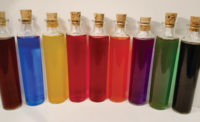All-natural has gotten a little spicier — Spicy Caramel, Aji Amarillo, and Pink Peppercorn.
Those are the next big trends in the flavor industry, at least according to Sensient Flavors’ 2012 flavor prediction lists.
And, everywhere you look there seems to be an expansion in the types of flavors consumers are demanding. For example, Innova Market Insights found that its floral flavors selection rose 7% in the first 10 months of 2011 compared to the same period in 2010, while Comax Flavors released a prediction that highlighted pickled flavors.
The innovation is at least partly a result of more consumers demanding natural products.
“The ability to offer more and more natural flavors is very important,” says Emil Shemer, food solutions director at Sensient Flavors. “Something like 30% of our consumers look for natural products.”
The growth in natural flavors feeds itself — as demand rises for natural flavors, companies work to open up sources for hard-to-get materials. As those sources open up, demand increases, and even more source options open up.
“Most of the demand seems to be coming from the same ‘back to whole/real foods’ movement that is shaping other food categories,” says Chris Schmidt, research analyst at Euromonitor International.
While processes to obtain natural flavors have been around since the 1890s, it is the widening availability of some raw materials that has helped companies increase variety. However, they still face many barriers. As Phil Sprovieri, v.p. of sales and marketing at Flavorchem, notes, acquiring the base materials for natural flavors can be difficult and expensive.
For example, Flavorchem receives some materials from the juice industry — as juice makers create concentrates or juice, they collect the vapors from the processes and condense them into oils — but the amount of oil they receive can be extremely small.
“You’ll have some 10,000 lbs. of product working through, and you might capture only 8 oz. to a pound from the process,” says Sprovieri.
Despite the drawbacks of the process, the demand is real enough to warrant such effort.
“The average candy consumer is driven more by taste, advertising and price than any sort of consciousness of the quality of ingredients, but as with the general food market, a growing number of Americans are becoming interested in all-natural and gourmet products,” says Schmidt, who notes that health concerns plays into this demand as well.
However, Schmidt sees the main drive toward all-natural flavors and confections as a desire for gourmet.
“While these health concerns are certainly moving some consumers toward natural confectionery, I would say most of the demand within is being driven by well-to-do customers looking to apply their gourmet tastes to every facet of their food consumption,” he says.
This demand is driven both by the perception of all-natural flavors as a healthier alternative to artificial flavors and by a growing interest in artisanal confections — an interest that perceives “all-natural” as an indicator of high quality.
“Consumers look for sophistication and indulgence to distinguish brands,” says Shemer. “There is a continued interest in discovery.”
Sensient, for example, released a flavor prediction for 2012 that included new twists on old favorites, including Spicy Caramel and Peach Rosemary — meanwhile, Flavorchem stocks flavors ranging from apple to zinfandel.
“There are two types of candy that use natural flavors,” says Sprovieri. “Old-fashioned fun candy, like hard candies that use real orange oil, and then higher-end candies that tend to have natural flavors.”
For the higher-end candies, offering only common natural fruit flavors such as cherry or orange is clearly not enough. That’s where slightly more exotic flavors like Sensient’s Spicy Caramel come in.
“Spicy Caramel has a rich caramel taste with a sudden hit of heat and extremely complex flavors,” says Shemer, adding that while caramel is an extremely common flavor profile, Spicy Caramel provides sophistication and complexity.
All those factors have also made dark chocolate an ideal vehicle for natural flavors — it’s healthy and gourmet.
“You have a lot of the health benefits with dark chocolate, so fruit flavors that go well with chocolate have expanded and will continue to expand,” says Shemer.
This includes flavors from the so-called “superfruits” such as pomegranate and acai — healthy flavor profiles that also have become familiar to consumers.
“The use of natural flavors has become more common in confectionery, especially in chocolate,” says Ed McIntosh, marketing manager at Flavorchem.
In fact, Mintel research shows that 208 of the 280 new natural flavors released in 2011 were used in chocolate — more than 74%.
As for what the future holds, growth in the natural flavors market is almost a foregone conclusion.|
“As consumers continue to look for healthier food, I see growth not only this year but in the future,” says Shemer.
Sprovieri agrees, but cautions that not all types of natural flavors will expand — producing certifiably organic will pose problems.
“While natural flavors will grow and keep growing, organic flavors are tough to produce,” says Sprovieri. “When you derive these oils for the flavors, you might use a solvent that is a no-no for organic certification. In that case you’d have to find a smaller company who uses water distillation.”
In any case, natural flavors aren’t going away anytime soon. And as manufacturers get better at imitating Mother Nature, expect an increase in variety — even black garlic has been captured.






